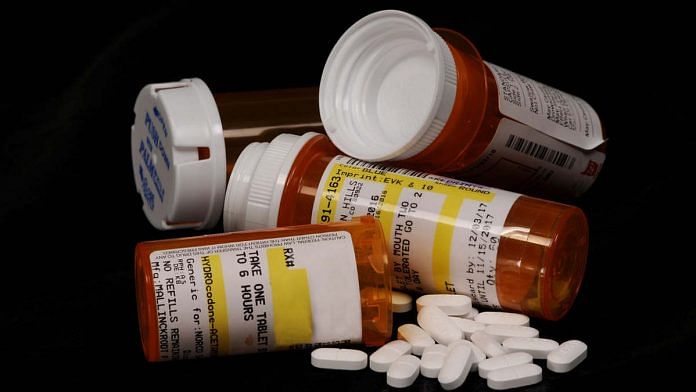New Delhi: Top drug-makers and pharmacies in the United States are fighting legal battles to dismiss claims that they caused the opioid crisis in the country resulting in almost 4,00,000 deaths between 1999 and 2017.
Of these, about 2,18,000 deaths are linked to prescription opioids.
Indian-born pharma tycoon John Kapoor has recently been sentenced to 5 years and 5 months in prison for overseeing a scheme to bribe medical professionals to use his opioid-based medicines. He is the first big name to be jailed in the US in connection with the opioid crisis.
76-year-old Kapoor has been convicted for leading a racketeering conspiracy that fuelled the crisis in the US. His company Insys Therapeutics Inc allegedly bribed doctors by pushing the sales of Subsys, a highly addictive painkiller, through unethical marketing practices.
The company also allegedly hired a stripper as a sales executive who gave a doctor a lap dance to get him to prescribe opioids.
In addition to bribing doctors, Insys developed an in-house call center whose representatives duped insurance companies into covering the costs of Subsys by falsely claiming that patients were suffering from cancer pain — the intended use for Subsys.
Opioid mess in the US
Drug-makers such as Johnson & Johnson, Purdue Pharma, pharmacy operators CVS Health and Walmart Inc and distributors are accused of not stopping the growing addiction of opioids among Americans that killed around 130 people, on an average, every day.
Last year, Johnson & Johnson was ordered to pay $572 million in the first trial of a drug manufacturer for the destruction wrought by prescription painkillers.
There are around 2,600 lawsuits pending against several drug-makers and sellers.
Purdue Pharma is known to have driven the early stages of the US opioid crisis by promoting opioid analgesic OxyContin in unethical manner where the company allegedly misrepresented its risk of addiction when used to treat non-cancer pain.
Another US based drug firm Mundipharma is reported to have “actively lobbied to open up European countries to greater opioid prescribing as well as sponsored doctors to promote prescription opioids and deny their high potential for addiction”.
Also read: Amritsar-born Indian American executive sentenced to 66 months for Opioid fraud
Drug firms blame doctors for the crisis
Top pharmacy chains, including CVS, Walgreens and Walmart, have sued doctors claiming that “physicians are the real culprits in the nation’s deadly drug epidemic”.
While some pharma companies and drug distributors have been ordered to pay hefty penalties in settlements and also given prison sentencing, they have not been held liable so far.
These pharmacy companies contended that doctors and other prescribers should have to pay some of the penalty if the drugstore chains are found liable at trial.
What are opioids?
Opioids are a class of drugs naturally found in the opium poppy plant.
According to the World Health Organisation (WHO), the name poppy is derived from Latin meaning “sleep inducing”.
“This raw opium is processed to obtain various alkaloids namely morphine, codeine and papaverine, which have clinical usefulness,” it said.
Opioids include the illegal drug heroin, synthetic opioids such as fentanyl and pain relievers available legally on prescription such as oxycodone, codeine, morphine, among others.
Sold for recreational purposes, heroin is an illegal drug and highly addictive form of opioid with no sanctioned medical use.
Opioid access is a double-edged sword. Given in small doses, under supervised conditions it can provide phenomenal relief from chronic and acute pain. But, if not supervised, it carries a high risk of addiction.
When are they administered & how do they work?
Opioids are medications given by doctors to treat severe pain mostly to patients recovering from surgery or those suffering from persistent pain due to cancers, mostly in terminal stages or during the organ transplants. It is also administered to patients who have serious injuries or who have got hurt due to fatal accidents.
But how do they work?
According to the American Society of Anesthesiologists (ASA): “Opioids attach to proteins called opioid receptors on nerve cells in the brain, spinal cord, gut and other parts of the body.” Anesthesiologists are medical doctors who specialise in pain management.
Once attached, the opioids block pain messages sent from the body to the brain. They can effectively relieve pain but are highly addictive, especially when taken over a long period of time.
“Opioids can make your brain and body believe the drug is necessary for survival,” the ASA said.
Opioid paradox in India
In India, the problem is exactly the opposite of the US. In India, due to restrictive pharmaceutical laws and stringent punishments, patients have limited access to opioid-based pain relief medicines.
One of the common concerns of ‘palliative care campaigners’ is the limited access to pain relievers in India.
These medicines are regulated under Narcotic Drugs and Psychotropic Substances Act (NDPS), 1985, along with the Prevention of Illicit Trafficking in Narcotic Drugs and Psychotropic Substances Act, 1988.
The laws — which include a 10-year mandatory minimum prison term for violations — are credited for limiting the availability of these medications in India.
A report by the UK-based publishing house, New Internationalist, says the use of medicinal morphine in India dropped by a staggering 97 per cent since the introduction of the NDPS Act, 1985.
The Indian government, however, amended the NDPS Act in 2014. The amended Act recognised the need for pain relief as an important obligation of the government.
But the access and knowledge remain low.
“To this day, even after the legal amendment in 2014, 70 per cent of the country’s population are still not getting opioids for their pain management,” said Dr Sushma Bhatnagar, the President of the Indian Association of Palliative Care.
“This is directly because there is a lack of knowledge that means people who need them can’t get them. Medical professionals across India are still just learning about them,” he added.
Also read: Taking opioids for chronic pain: The truth no one’s telling you



